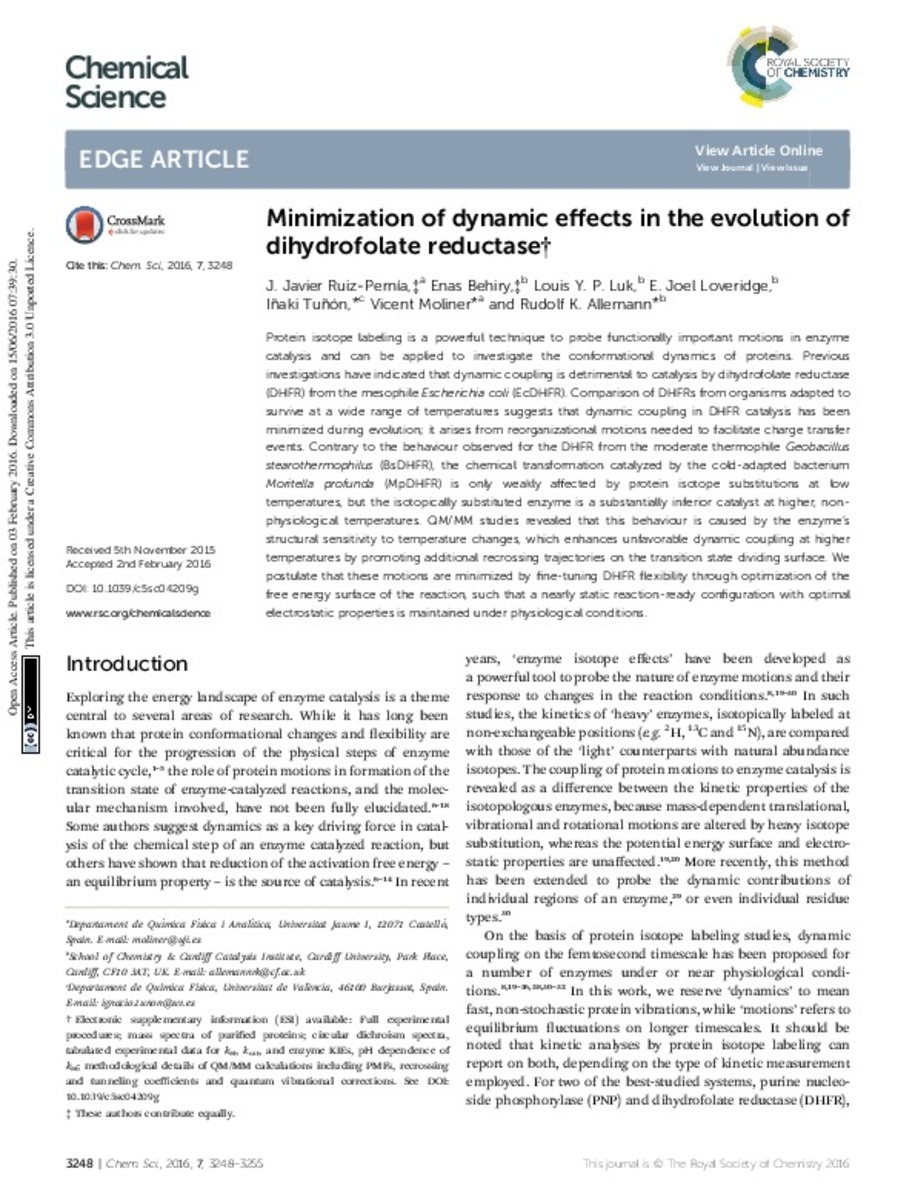Mostrar el registro sencillo del ítem
Minimization of dynamic effects in the evolution of dihydrofolate reductase
| dc.contributor.author | Ruiz-Pernía, José Javier | |
| dc.contributor.author | Behiry, Enas | |
| dc.contributor.author | Luk, Louis Y. P. | |
| dc.contributor.author | Loveridge, E. Joel | |
| dc.contributor.author | Tuñón, Iñaki | |
| dc.contributor.author | Moliner, Vicent | |
| dc.contributor.author | Allemann, Rudolf K. | |
| dc.date.accessioned | 2016-06-15T06:55:23Z | |
| dc.date.available | 2016-06-15T06:55:23Z | |
| dc.date.issued | 2016 | |
| dc.identifier.citation | RUIZ-PERNÍA, J. Javier, et al. Minimization of dynamic effects in the evolution of dihydrofolate reductase. Chemical Science, 2016, vol. 7, no 5, p. 3248-3255. | ca_CA |
| dc.identifier.issn | 2041-6520 | |
| dc.identifier.uri | http://hdl.handle.net/10234/160709 | |
| dc.description.abstract | Protein isotope labeling is a powerful technique to probe functionally important motions in enzyme catalysis and can be applied to investigate the conformational dynamics of proteins. Previous investigations have indicated that dynamic coupling is detrimental to catalysis by dihydrofolate reductase (DHFR) from the mesophile Escherichia coli (EcDHFR). Comparison of DHFRs from organisms adapted to survive at a wide range of temperatures suggests that dynamic coupling in DHFR catalysis has been minimized during evolution; it arises from reorganizational motions needed to facilitate charge transfer events. Contrary to the behaviour observed for the DHFR from the moderate thermophile Geobacillus stearothermophilus (BsDHFR), the chemical transformation catalyzed by the cold-adapted bacterium Moritella profunda (MpDHFR) is only weakly affected by protein isotope substitutions at low temperatures, but the isotopically substituted enzyme is a substantially inferior catalyst at higher, non-physiological temperatures. QM/MM studies revealed that this behaviour is caused by the enzyme’s structural sensitivity to temperature changes, which enhances unfavorable dynamic coupling at higher temperatures by promoting additional recrossing trajectories on the transition state dividing surface. We postulate that these motions are minimized by fine-tuning DHFR flexibility through optimization of the free energy surface of the reaction, such that a nearly static reaction-ready configuration with optimal electrostatic properties is maintained under physiological conditions. | ca_CA |
| dc.description.sponsorShip | This work was supported by Cardiff University, by grants BB/ J005266/1 and BB/L020394/1 (RKA) from the UK Biotechnology and Biological Sciences Research Council (BBSRC), by FEDER and Ministerio de Econom´ıa y Competitividad funds (project CTQ2012-36253-C03), by Generalitat Valenciana (ACOMP/2014/ 277 and PrometeoII/2014/022) and by Universitat Jaume I (Project P1 1B2014-26). | ca_CA |
| dc.format.extent | 8 p. | ca_CA |
| dc.format.mimetype | application/pdf | ca_CA |
| dc.language.iso | eng | ca_CA |
| dc.publisher | Royal Society of Chemistry | ca_CA |
| dc.rights | © The Royal Society of Chemistry | ca_CA |
| dc.rights | Attribution 4.0 Spain | * |
| dc.rights.uri | http://creativecommons.org/licenses/by-sa/4.0/ | * |
| dc.subject | enzyme catalysis | ca_CA |
| dc.subject | dihydrofolate reductase | ca_CA |
| dc.subject | dynamic effects | ca_CA |
| dc.subject | Escherichia coli | ca_CA |
| dc.title | Minimization of dynamic effects in the evolution of dihydrofolate reductase | ca_CA |
| dc.type | info:eu-repo/semantics/article | ca_CA |
| dc.identifier.doi | http://dx.doi.org/10.1039/C5SC04209G | |
| dc.rights.accessRights | info:eu-repo/semantics/openAccess | ca_CA |
| dc.relation.publisherVersion | http://pubs.rsc.org/en/content/articlelanding/2016/sc/c5sc04209g#!divAbstract | ca_CA |
| dc.type.version | info:eu-repo/semantics/publishedVersion | ca_CA |
Ficheros en el ítem
Este ítem aparece en la(s) siguiente(s) colección(ones)
-
QFA_Articles [819]
Articles de publicacions periòdiques








